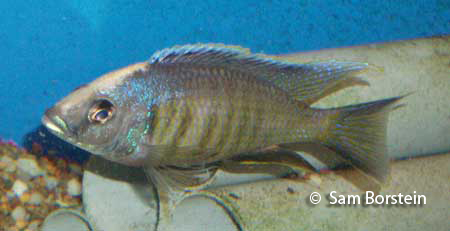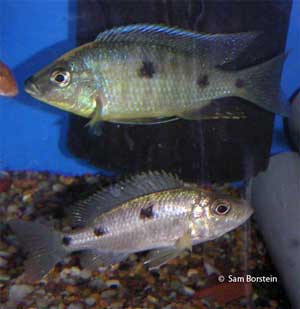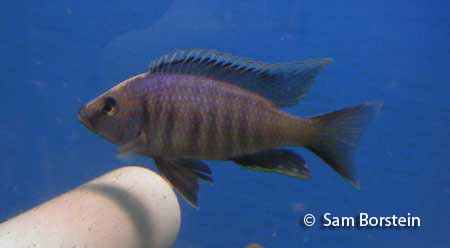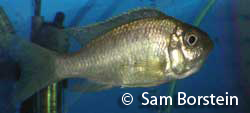Copadichromis sp. "kawanga"
Kawanga Borleyi
Above: A male Copadichromis sp. "kawanga". Photo by Sam Borstein.
Etymology:
Genus- Kopas= carved (Greek), chromis= a fish, perhaps a perch (Greek).
Intro:
Copadichromis sp. "kawanga" is an undescribed species of Copadichromis that is new to the hobby. In body shape, this fish resembles that of Copadichromis borleyi, where it gets its common name from, the "Kawanga Borleyi".
This fish changes color faster than a chameleon and often. The change of this fishes color can vary over a large spectrum of possibilities. Both females and males can readily lose the three dots on their sides, and males can change from a mostly gold colored fish, to a fish that is predominantly blue and can gain or lose stripes. The only thing that stayed common in this fishes color was the creamy yellow-white blaze on both the male and females forehead. I thought it was pretty cool the female also developed this blaze, as that is not seen in many cichlids.
I believe most of the color changes are due to behavior and stress, but either way, this fish changes more often than any fish I've ever kept.
Distribution:
This fish is found throughout the rocky habitats of the North Western part of the North Eastern shore line of Lake Malawi.
Size, Maturity, and Sexual Dimorphism:
Size: Males- 7inches, Females- 6 inches
Maturity: 3.5 inches
Sexual Dimorphism: Males are larger than females, and are a lot more colorful than the females which are silver. Both fish get the creamy blaze on their heads.
Care:
Copadichromis sp. "kawanga" is easy to care for. This fish is relatively calm, and peaceful. The only real aggression I saw was during spawning. This fish does occasionally hold territories, so for a group of 4 at about 4 inches I recommend a 75 community tank.

Above: A Pair of Copadichromis sp. "kawanga". The male is on top, female on the bottom. Photo by Sam Borstein.
Diet:
In the wild Copadichromis sp. "kawanga" is a planktivore. In the aquarium this fish will accept any type of food. Feed a mix of flakes and pellets.
Breeding:
Copadichromis sp. "kawanga" is easy to breed. The key is getting the females into breeding condition. Other than that the fish are relatively prolific. Females usually will spawn once per month. The male, will have an extreme color change before spawning, other than that spawning takes place in the ordinary Malawi Haplochromis fashion.

Above: A male Copadichromis sp. "kawanga" in breeding color. Photo by Sam Borstein.
Females were good holders and held term, which was about 22-24 days. The fry are pretty good size and do great on a diet of baby brine shrimp and will thrive on flake once large enough.

Above: A female Copadichromis sp. "kawanga" holding eggs. Photo by Sam Borstein.
Conclusion:
Copadichromis sp. "kawanga" is a nice fish. The color changes in this fish are cool, but in he end this is just another Malawi Hap. There really isn't anything very special about this fish. This fish can be hard to obtain because it's not very accessible in the hobby right now. If you like Malawi Haps, you can give this fish a try.
References:
- Konings, A. (2007) Malawi cichlids in their natural habitat. 4th ed., Cichlid Press, El Paso, Texas, 424 pp.
